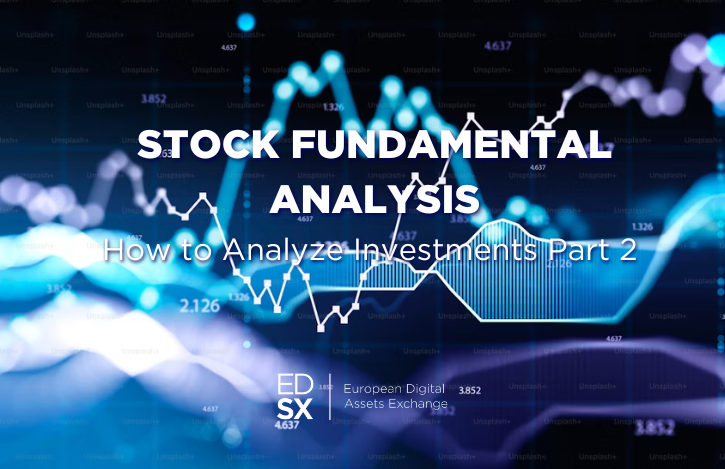Earlier in this series, we looked at how conducting an in-depth analysis is important for creating investment strategies. Exploring diverse analytical approaches, it becomes evident that delving into a company’s fundamental financials is paramount for informed investment choices. Among these methods, stock fundamental analysis emerges as particularly valuable yet often overlooked. Through a meticulous examination of critical indicators such as revenue, earnings, balance sheet structure, and corporate vision, fundamental analysis empowers investors to uncover the genuine value of a security, transcending transient market fluctuations.
As defined by analysts, fundamental analysis encompasses evaluating both internal and external factors that influence a business. This includes macro-level exploration alongside micro-level examination of financial statements, cash flows, as well as management effectiveness over time. Fundamental analysis consists of three main parts: economic analysis, industry analysis, and company analysis. This holistic approach arms discerning investors with insight to identify underpriced stocks and bonds before consensus estimates catch on.
For example, by comparing financial ratios and returns on capital against peers through industry analysis, fund managers at Capital Group gain perspective into competitive advantages and potential issues ahead of time. Regularly assessing profitability composition and margins through company analysis also provides insight into sustainable profit drivers. Such diligent analytic practices form the basis of well-constructed portfolios braced for changing conditions.
Factors for Fundamental Analysis
Fundamental factors utilized in analysis can broadly be classified into two main categories: quantitative measures derived from financial statements and reports, as well as qualitative aspects concerning the business’ model, management team, and industry dynamics. Some of the measures are as follows.
Qualitative Fundamentals to Analyze
- Business Model: A thorough examination of the company’s core operations, revenue drivers, target markets, products/services, and strategy. Assess sustainability of the model and ability to adapt.
- Competitive Advantage: Identify unique strengths like proprietary technology, brand reputation, economies of scale or customer lock-in that protect profits and market share from competitors. Consider barriers to entry that withstand disruption.
- Management: Scrutinize experience in relevant industries, past leadership roles, compensation structure, and strategy execution track record. Analyze ownership stake to ensure management interests align with shareholders. Monitor insider transactions.
- Corporate Governance: Evaluate board independence, shareholder rights, executive compensation policies, transparency of financial reporting and disclosures for signs of responsible stewardship and accountability. Identify red flags like related party transactions.
- Industry Analysis: Assess trends like consolidation, regulation, technology shifts influencing demand and competitive dynamics. Identify threats from new entrants or substitute products. Consider industry growth rate and maturity relative to broader economy.
Quantitative Fundamentals to Analyze
- Balance Sheet: Dissect asset composition for intangibles, receivables quality and inventory levels influencing cash flows. Calculate financial leverage, liquidity ratios and working capital to assess risks.
- Income Statement: Identify profitable revenue sources together with analyze gross/operating margins over time. Monitor declining profits as sign of competitive weaknesses until explained.
- Cash Flow Statement: Ensure positive operational cash flows adequately fund strategically important capital expenditures and investments. Identify undisclosed liabilities draining cash balances.
- Key Ratios: Calculate returns on equity/assets, debt-coverage ratios and valuation multiples internal and relative to peers for quick analysis of financial position and performance.
When conducting stock fundamental analysis, it’s essential to factor in industry dynamics, including market growth prospects, customer dependency, competition, and regulation. Combining qualitative and quantitative assessments helps build a comprehensive fundamental profile of a company’s long-term potential and risks. Consistent review enables the identification of strategic shifts or deteriorations ahead of the consensus. Employing a balanced, research-driven approach assists in pinpointing attractively-priced opportunities and risks amidst evolving market conditions.
Of course, a fulsome fundamental analysis requires comprehending the building blocks of corporate finance. The balance sheet, in particular, lays bare a company’s financial underpinnings through its depiction of assets, liabilities, and owner equity. By dissecting line items thoroughly through balance sheet analysis, Prudential Investment analysts uncover flexibility, risks, and leverage.
Analysis Made for Long-Term Success
Overall, a steadfast approach grounded in thorough research and anchored by the bedrock of a company’s intrinsic metrics has proven its worth over time. Both individual investors and seasoned professionals benefit from regularly applying these methodologies, honing their skills to pinpoint companies poised for enduring success, irrespective of market fluctuations. At its core, fundamental analysis distills valuations to their purest form, stripping away the surrounding distractions. This enduring strategy, often referred to as stock fundamental analysis, remains indispensable for those seeking to navigate the complexities of the financial landscape.

Based in Zug, the platform is fully compliant with all Swiss laws related to financial intermediaries, banking, anti-money laundering, and organized trading facilities. Among its core values, there are innovative solutions through blockchain technology, which ensures security and liquidity.
EDSX is the first platform in Europe with primary and secondary markets for both institutional and retails. EDSX is a pioneering platform that employs the world’s leading technology to globally list security tokens in both primary and secondary markets, listing digital securities of real financial instruments to the public with a decentralized peer-to-peer exchange. Our goal is to fully engage every aspect of the financial revolution.
Do you have a question for us?
Send your query here:
[email protected]

